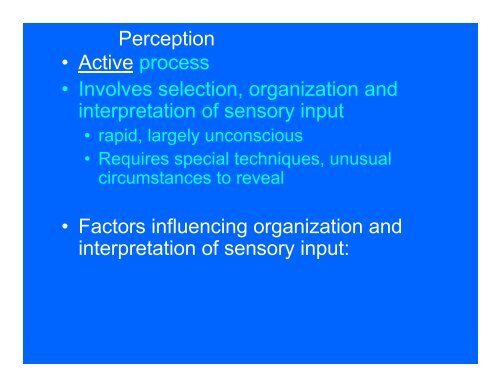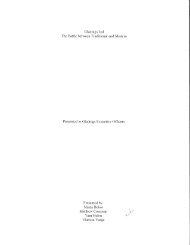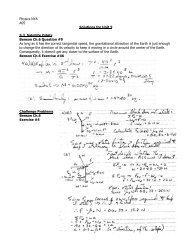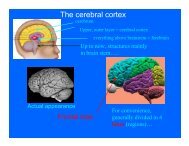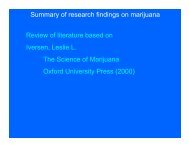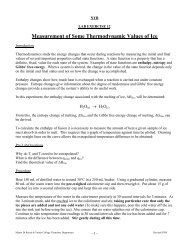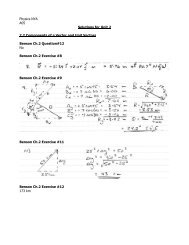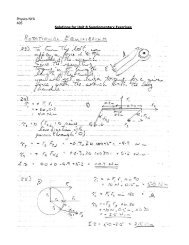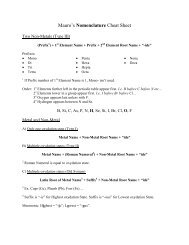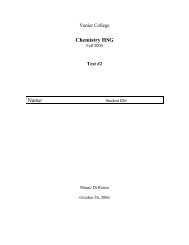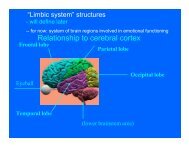Perception • Active process • Involves selection, organization and ...
Perception • Active process • Involves selection, organization and ...
Perception • Active process • Involves selection, organization and ...
You also want an ePaper? Increase the reach of your titles
YUMPU automatically turns print PDFs into web optimized ePapers that Google loves.
<strong>Perception</strong><strong>•</strong> <strong>Active</strong> <strong>process</strong><strong>•</strong> <strong>Involves</strong> <strong>selection</strong>, <strong>organization</strong> <strong>and</strong>interpretation of sensory input<strong>•</strong> rapid, largely unconscious<strong>•</strong> Requires special techniques, unusualcircumstances to reveal<strong>•</strong> Factors influencing <strong>organization</strong> <strong>and</strong>interpretation of sensory input:
1. Past experience.
<strong>•</strong> Factors influencing your perception<strong>•</strong> Past experience with cows in general<strong>•</strong> Your experience with the drawing>
2. Gestalt organizing principles (tendencies)<strong>•</strong> Gestalt psychologists:<strong>•</strong> Recognized- we seek meaning, pattern,structure<strong>•</strong> Asked: Any basic tendencies governinghow we organize sensory input?<strong>•</strong> Found several
e.g., Continuity<strong>•</strong> What do you see?<strong>•</strong> How many lines?<strong>•</strong> We have preference for continuous figures(also illustrates “Closure”)
e.g., Proximity<strong>•</strong> Describe what you see<strong>•</strong> Not just dots (we organize); <strong>and</strong> not rows<strong>•</strong> Principle: things which are closer togetherwill be seen as belonging together
e.g., ** figure-ground separation **<strong>•</strong> [describe]<strong>•</strong> “Figure” st<strong>and</strong>s out, seen in more detail<strong>•</strong> rest seen in less detail, recedes intobackground<strong>•</strong> (May not even be noticed)
Figure-ground reversals
3. Perceptual set<strong>•</strong> Experiment [instructions]>
[instructions]Group B>.
(check results….)
<strong>•</strong> Perceptual set (= expectation) caninfluence what we perceive<strong>•</strong> “tunes” our perception<strong>•</strong> Plays significant role in perception ofpain1) Anticipation of pain experiment[describe]2 groups of subjects (experimental <strong>and</strong> control groups)All Ss told: “measuring physiological effects of differenttypes of music…”Experimental group Ss were given additional info: “By theway….”
<strong>•</strong> Experiment proceeds….music played<strong>•</strong> Over next 20 min., Ss (in both groups) do receive a few mildelectric shocks<strong>•</strong> At end: Ss asked for comments<strong>•</strong> Then fill out questionnaire<strong>•</strong> Results:<strong>•</strong> Asked to rate severity of shocks<strong>•</strong> Ss in experimental group:<strong>•</strong> More likely to notice, rated shocks as more severe<strong>•</strong> Expectations influence perception of pain<strong>•</strong> Purely psychological?…
<strong>•</strong> Porro et al. (2002) fMRI study: scanned Ssanticipating injection in specific foot<strong>•</strong> Heightened activity (though less intense), duringwaiting period, in regions of brain activatedwhen actual pain experiencedAnterior cingulate cortex (ACC) <strong>and</strong> insulasomatosensory projection area (contralateral)<strong>•</strong> “Priming effect”: cognitive activity sensitizing.sensory/affective regions
2) Placebo Effect<strong>•</strong> If expectation of pain can increase pain intensity,<strong>•</strong> how might expectation of pain reduction influenceperception?<strong>•</strong> e.g., following surgery [describe scenario where placebo might be given]<strong>•</strong> Experimental results<strong>•</strong> E.g., 85% of Ss given placebo for relief of paincaused by Herpes (cold sores or genital sores)reported pain reduction<strong>•</strong> E.g., 56% of patients given sham treatment(small skin incision) for angina (heart pain)reported significant pain reduction<strong>•</strong> On average, 33% of Ss in placebo pain studiesreport pain reduction
Why the high responsiveness to expectationof pain relief?<strong>•</strong> Evidence that expectation of pain relief activatesmu-opioid neurotransmitter system (“endorphins”)Red & orangeindicate regions ofheightened muopioidactivitywhen P reportspositive effect ofplaceboZubieta et al - Placebo Effects Mediated by Endogenous Opioid Activity on µ-Opioid Receptors (2005)


